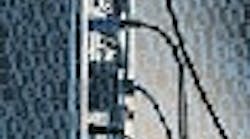THE CONFIDENCE that comes from knowing you have stable control signals gives industrial machine builders opportunities to create simpler designs and, consequently, easier manufacturing processes.
Signal conditioning requirements stem from operating environment conditions or sensor specifications. Environmental conditions such as exposure to electronic noise, human operator safety or equipment sensitivity dictate the need for isolation, filtering and amplification. "Isolation is important for both analog and digital signals to protect operators and expensive equipment from high-voltage spikes, while filtering and amplification are needed to obtain an accurate reading in noisy, industrial environments," says Brett Burger, product engineer at National Instruments.
Filtering and amplification add value to all measurement readings, but some sensors require specific methods of signal conditioning. “Thermocouples and bridge-based transducers, which include force, load, pressure and strain sensors, dominate the industry,” adds Burger. “Thermocouples require cold-junction-compensation (CJC) to eliminate error caused by Seebeck voltages, which is the production of a small voltage across the length of a wire due to a difference in temperature along that wire, at the sensor interface to the measurement system. Amplification increases the mV output from the sensor, thereby improving the signal-to-noise ratio and optimizing the voltage level to the range of the data acquisition system.”
Bridge-based sensors require bridge completion, excitation to power the sensor, and amplification to increase the output. These are the most prevalent forms of signal conditioning for sensors, while commercial signal conditioning products cover all common industry uses for sensors and industrial measurement environments.
"Traditionally, machine builders had to construct custom circuitry to create cost-effective, signal conditioning solutions," explains Burger. "Building those in-house solutions often meant engineers spent a substantial amount of time on system construction. Today, however, the industry provides machine builders with commercial technologies in small, modular form factors that enable faster setup time and better signal conditioning solutions.”
System modules provide isolation to prevent ground loops, surge suppression, signal amplification and noise immunity. Isolation technology selection depends on cost, size and performance. "Optical isolators provide the lowest cost, but are more sensitive to electrostatic discharge (ESD) and common-mode transients,” says Davis Mathews, business unit manager at Phoenix Contact. “Magnetic isolation provides high accuracy, robustness and efficiency, but at a higher cost.” In some cases, manufacturers of electronic components and signal isolators use a combination of technologies.
Modular solutions consist of a chassis or connecting unit that accommodates a selection of signal conditioning by blocks of channels. The ability to mix and match these modules in the chassis provides a solution with home-built specs and commercial delivery time. In addition to cost and time savings, these signal conditioning platforms blend in nicely with high-speed deterministic control, motion control or even machine imaging.
Relevant trends in automation include more distributed measurement and control and smaller, lower cost input/output (I/O) modules. In order to meet these requirements, isolation and conditioning sometimes are left out of the I/O function, resulting in problems later, such as ground loops and noise that then require external signal conditioners. "As this trend continues, signal conditioner requirements will be designed more on the front end, or retrofitted later,” suggests Mathews. “Signal conditioners are versatile and a cost-effective problem solvers for improving measurement and control system reliability, compatibility, and flexibility.”
Calibration and programming of signal conditioners also has been an evolving trend, with more and more products offering PC or handheld programming, data-logging capability and wireless interfacing. Newer formats transmit signals in a peer-to-peer mode over any Ethernet media. This reduces wiring and conduit around the machine by pulling one Ethernet cable rather than several individual signal cables. "Ethernet modules and switches even support redundancy for critical signal processes, increase transmission speed, and reduce weight by replacing individual copper cables with a single copper or fiberoptic Ethernet cable," says Lee Sochay, process products sales engineer for Acromag. “Incorporating the benefits of the signal conditioners with Ethernet technology can greatly reduce costs and improve quality and productivity.”
The need for high-performance signal isolators and conditioners requires highly functional, accurate, universal microprocessor-based products in a compact package at a moderate price per point. New transformer component technology and signal conditioner designs allow tiny packaging, full function, and high-isolation values (1.5 kV) without heat-dissipation problems. With power dissipation of less than 400 mW per channel, these signal conditioners can mount adjacent to each other, providing maximum functionality in even the smallest distributed measurement and control cabinet applications.
| About the Author |



